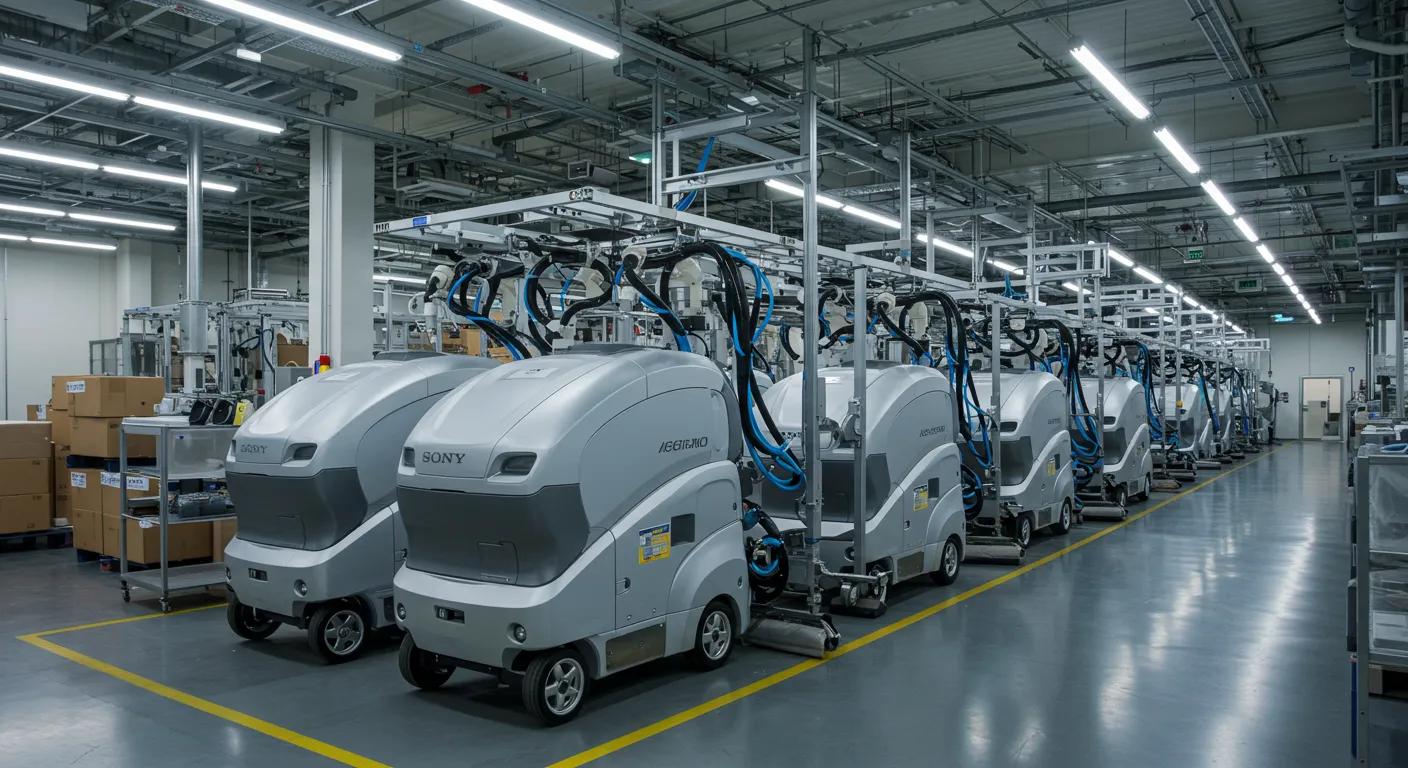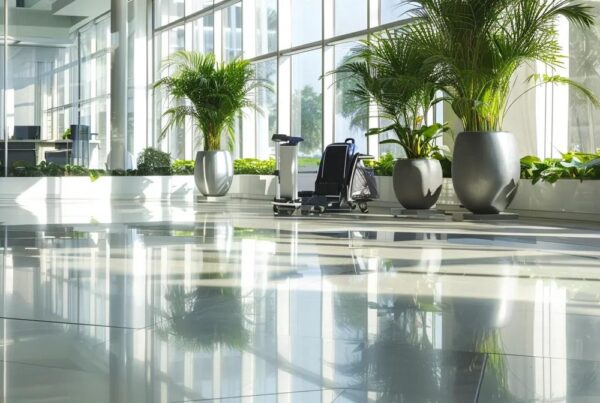Industrial Cleaning for Manufacturing Facilities: Key Insights
Industrial cleaning in manufacturing environments goes far beyond standard janitorial services by emphasizing operational efficiency, compliance, and worker safety. Many modern facilities are now embracing green cleaning practices to minimize environmental impact while maintaining strict standards. In modern production areas, the cleanliness of machinery, floors, and overhead structures is critical for product quality and employee morale. Businesses face challenges from heavy contaminants, specialized equipment, and strict regulations that demand tailored sanitation strategies, including make-ready protocols that prepare surfaces for optimal cleaning performance. This article explains the core principles of industrial cleaning, its differences from commercial cleaning, specialized techniques for manufacturing zones—such as soft-washing for delicate equipment finishes—compliance requirements, outsourcing benefits, and guidelines for selecting a proficient cleaning provider. Effective cleaning strategies not only prolong equipment lifespan but also create a safer workplace and uninterrupted production cycles while enhancing customer satisfaction.
The sections below delve into core principles, specialized techniques, safety standards, outsourcing benefits, and provider selection criteria, ensuring a comprehensive understanding of industrial cleaning for manufacturing facilities.
Understanding Core Principles of Industrial Cleaning in Manufacturing Environments
Industrial cleaning in manufacturing differs markedly from everyday janitorial tasks. Its primary goal is to minimize both microbial and chemical contamination that can jeopardize sensitive production processes and compromise product quality. This section outlines key concepts including the specialized nature of industrial cleaning, its objectives, and strategies tailored to different manufacturing sectors.
Differentiating Industrial Cleaning From Standard Janitorial Services
Industrial cleaning targets heavy grime, chemical residues, and specialized contaminants that accumulate in production areas. Unlike regular janitorial services that focus on general tidiness, industrial cleaning employs high-pressure washing systems, HEPA-filtered industrial vacuums, and chemical degreasers. Removing chemical residues prevents slip hazards, machine malfunctions, and other production errors. Advanced cleaning agents and methods ensure thorough decontamination, thereby extending machinery life and lowering maintenance costs.
Key Objectives of Maintaining Cleanliness in Production Areas
Maintaining a clean manufacturing environment serves several critical purposes:
- It safeguards equipment by removing contaminants that accelerate wear and tear.
- It minimizes cross-contamination that might damage product integrity.
- It creates a safer workplace by reducing accident risks.
- It enhances operational efficiency by reducing downtime.
Each objective contributes to high production quality, lower repair costs, and compliance with industry health and safety standards.
Tailoring Cleaning Protocols to Specific Manufacturing Sectors
Different manufacturing sectors demand customized cleaning strategies. For example, facilities producing electronics require stringent particulate control, while those producing food must emphasize sterilization and antimicrobial practices. Tailoring begins with identifying the contaminants, assessing production cycle sensitivities, and selecting appropriate chemicals and equipment. Well-adapted cleaning plans can significantly improve machine longevity by effectively removing corrosive substances.
The Role of Specialized Equipment in Industrial Cleaning Tasks
Specialized equipment is the backbone of industrial cleaning solutions. Tools such as industrial scrubbers, steam cleaners, and automated robotic systems navigate complex layouts and high-traffic zones. High-efficiency particulate air (HEPA) vacuums remove dust and airborne particles that regular tools miss. Advanced degreasing systems break down heavy oils and lubricants on machinery. This integration not only improves cleaning outcomes but also reduces worker exposure to hazardous chemicals.
Addressing Unique Contaminants Found in Manufacturing Plants
Manufacturing environments generate various contaminants including oils, chemicals, dust, metal shavings, and lubricant residues. Targeted methods—like solvent-based cleaning, high-pressure steam treatments, and specialized absorbents—are necessary to address these issues. In food or pharmaceutical production, extra measures such as sterilization and strict regulatory compliance further protect product integrity and employee safety.
Distinguishing Industrial Cleaning From Commercial Cleaning for Manufacturing Facilities
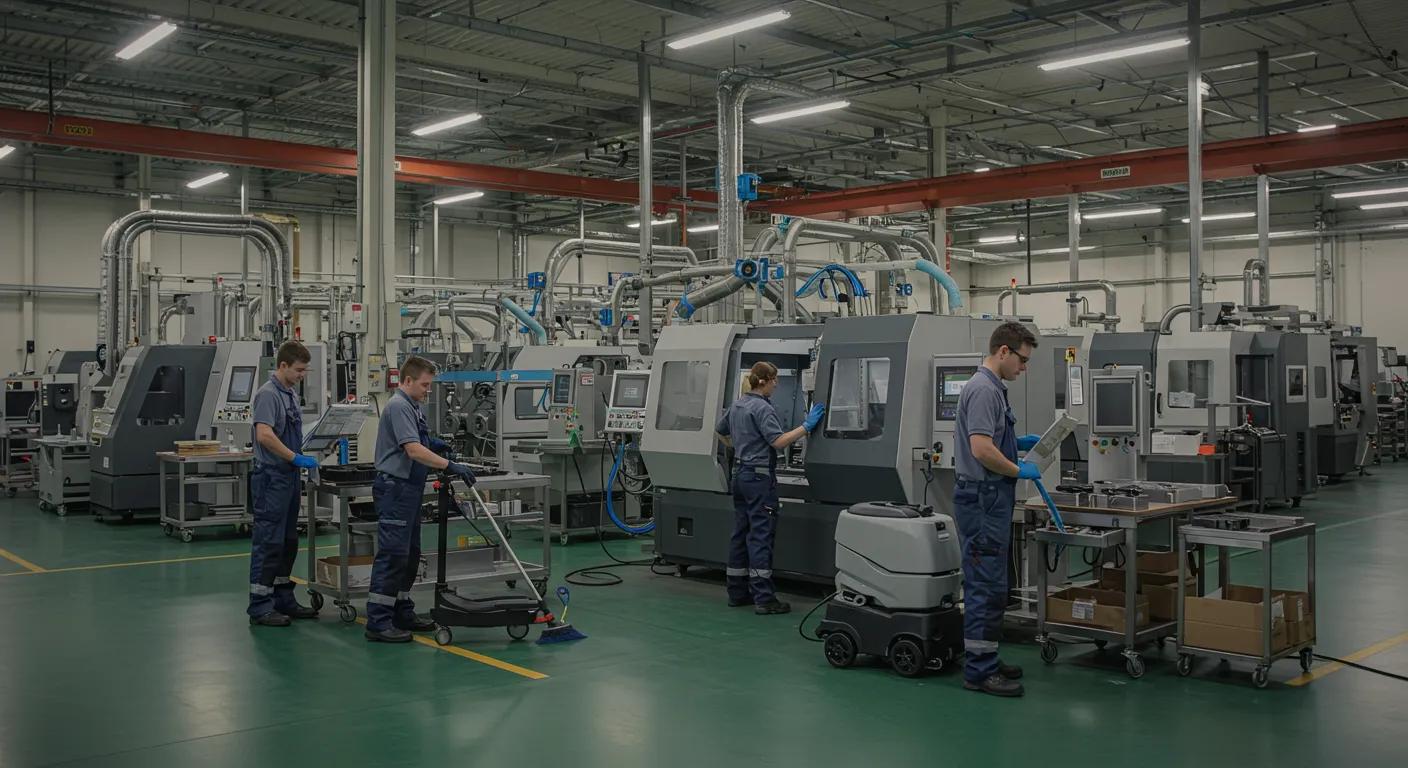
Although both services maintain facility cleanliness, industrial cleaning is significantly more complex due to the intensity of tasks, equipment demand, and safety requirements in manufacturing settings.
Comparing Task Intensity in Industrial Versus Commercial Cleaning Scenarios
Industrial cleaning in manufacturing involves handling heavy soiling, a broader range of contaminants, and more hazardous chemicals compared to commercial cleaning. While commercial cleaning might simply involve vacuuming carpets and dusting, industrial cleaning may require dismantling machinery for deep clean procedures. The increased physical labor and technical expertise necessitate rigorous safety protocols to protect workers from harmful substances.
Examining Equipment Differences for Industrial and Commercial Applications in Manufacturing
The equipment used in industrial cleaning is purpose-built to remove stubborn contaminants from production environments. Automated scrubbers and high-powered steam cleaners remove debris without damaging sensitive equipment, unlike commercial cleaning tools designed for offices. Industrial devices feature advanced controls, higher pressure systems, and robust filtration to handle diverse contaminants and sustain frequent use, directly contributing to improved equipment uptime.
Training and Expertise Requirements for Industrial Cleaning Staff
Industrial cleaning professionals receive specialized training in handling hazardous materials and operating advanced machinery. They must adhere to strict compliance and regulatory guidelines. Certifications, such as OSHA’s Industrial Cleaning Safety Course, ensure that only qualified technicians manage sensitive cleaning tasks, preserving both worker safety and production efficiency.
Frequency and Scheduling Considerations for Each Cleaning Type
Manufacturing facilities require frequent, scheduled maintenance to coordinate with tight production schedules. Routine cleaning during off-peak hours and deep-cleaning during planned shutdowns help minimize downtime. This contrasts with commercial cleaning schedules, which are generally less disruptive. Tailoring cleaning frequency to a facility’s unique production cycle is essential to keeping operations smooth and safe.
How Commercial Cleaning Services Adapt to Manufacturing Facility Needs
Commercial cleaning companies that serve manufacturing facilities customize their service contracts to meet rigorous industrial demands. They integrate advanced equipment, partner with industrial cleaning specialists, and establish detailed cleaning protocols that address the specific challenges of production environments. Bespoke cleaning schedules aligned with production cycles and downtime, along with on-site training for in-house staff, help merge traditional commercial cleaning with industrial-level precision.
Specialized Cleaning Techniques for Manufacturing Machinery and Production Zones
Manufacturing facilities require specialized techniques to maintain heavy machinery and production zones effectively. Deep cleaning methods for degreasing, high-level cleaning, confined spaces, waste management, and floor care are vital both for machine performance and regulatory compliance.
Methods for Degreasing and Sanitizing Heavy Machinery
Heavy machinery often accumulates grease, oil, and industrial residues that can impair performance and shorten lifespans. The degreasing process typically starts with applying solvent-based agents to break down contaminants, followed by high-pressure water jets and industrial brushes to remove residues. Sanitization with specialized disinfectants eliminates residual microbial contaminants. Regular degreasing can reduce machinery downtime significantly and enhance production efficiency.
High-Level Cleaning for Rafters, Ducts, and Overhead Structures
Overhead areas like rafters and ductwork are prone to dust buildup that can eventually contaminate production equipment. High-level cleaning employs specialized aerial platforms or suspended scaffolding to safely access these areas. Industrial vacuums with HEPA filters capture fine particles, maintain facility cleanliness, and improve air quality, all of which are critical in environments such as aerospace or semiconductor production.
Confined Space Cleaning Procedures and Safety Measures
Confined spaces, such as pits beneath machinery, require unique cleaning strategies due to restricted access and heightened safety risks. Strict protocols, including the use of PPE, gas monitoring, and lockout/tagout procedures, are essential to prevent accidents. Compact vacuums and manual brushes help clean these areas effectively while mitigating toxin accumulation and ensuring regulatory compliance.
Managing Industrial Waste and Byproduct Removal
Industrial cleaning generates waste in the form of contaminated water, chemical residues, and disposable materials. Effective waste management involves sorting waste into recyclable, hazardous, and non-hazardous categories, and using on-site treatment systems to neutralize contaminants. Proper documentation of waste removal processes is not only a regulatory requirement but also minimizes environmental impact and enhances facility safety.
Floor Care Solutions for Diverse Manufacturing Surfaces
Manufacturing floors encounter heavy foot traffic, spills, and industrial residues. Floor care solutions—such as power scrubbing, steam cleaning, and chemical treatments—remove deposits and restore floor appearance while preventing long-term damage that can lead to costly repairs. Sealing and polishing floors improve safety by reducing slip hazards and simplifying maintenance, ensuring both operational efficiency and durability.
List of Key Industrial Cleaning Techniques
- Degreasing Heavy Machinery – Using solvent-based agents and high-pressure water to efficiently remove industrial lubricants, preventing equipment malfunctions.
- High-Level Cleaning of Overhead Structures – Employing specialized platforms to vacuum contaminants from rafters and ducts, improving air quality.
- Confined Space Cleaning – Utilizing compact tools and stringent safety protocols to clean hard-to-reach areas, reducing risk.
- Waste Management – Sorting, treating, and disposing of industrial waste in line with EPA guidelines to ensure compliance.
- Floor Care Solutions – Applying power scrubbing and chemical treatments to maintain surface safety and extend floor life.
Upholding Safety and Compliance Through Rigorous Manufacturing Facility Cleaning
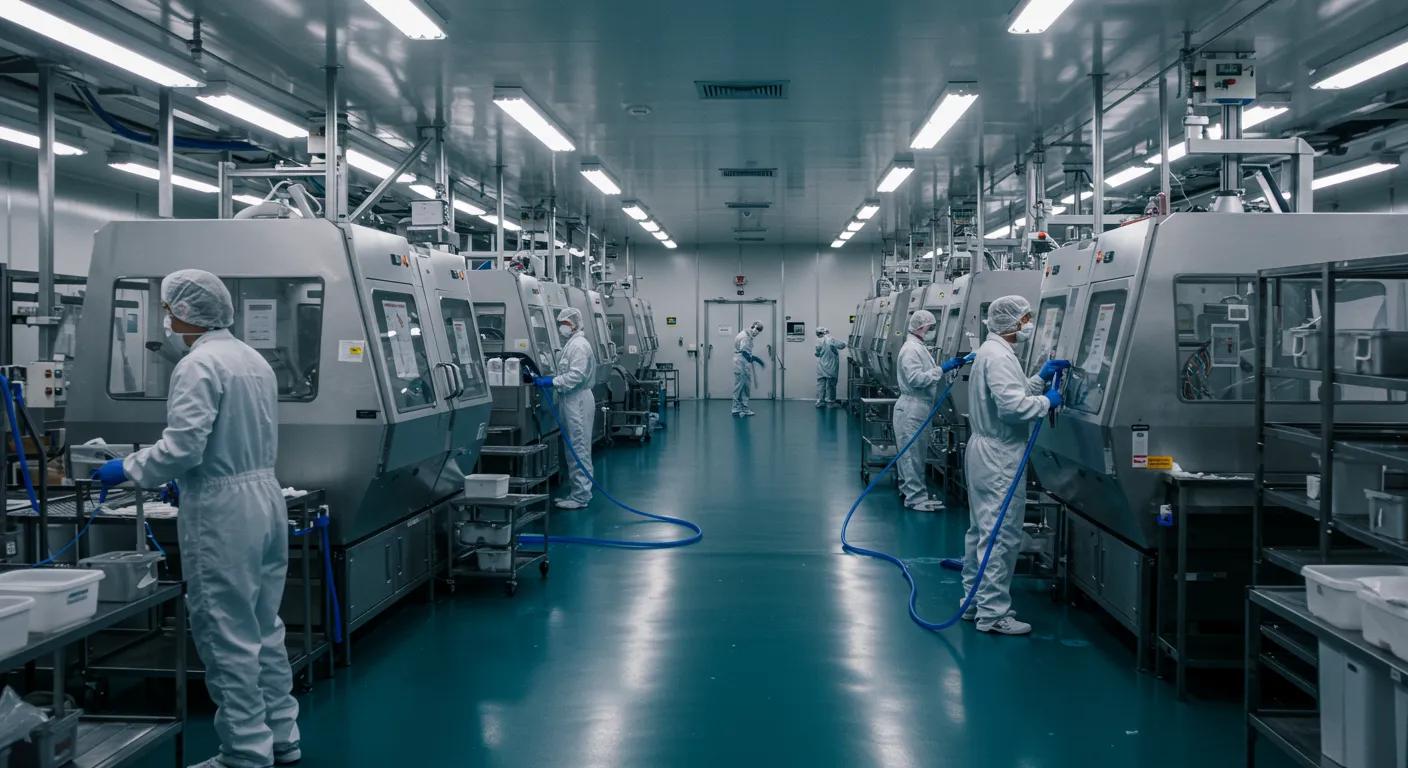
Safety and regulatory compliance are central to industrial cleaning in manufacturing facilities. This section explains how robust cleaning practices contribute to meeting OSHA requirements, adhering to EPA guidelines, and following industry-specific protocols, ultimately protecting workers and ensuring uncompromised production processes.
Meeting OSHA Requirements for a Safe Working Environment
OSHA standards require a safe working environment, and rigorous cleaning protocols address hazards such as slip-and-fall risks, chemical exposures, and waste buildup. Regular cleaning of machinery, floors, and overhead areas minimizes risks and keeps potential hazards in check. Proper documentation and periodic inspections support proactive safety improvements while reducing workplace accidents.
Adherence to EPA Guidelines for Waste Disposal and Chemical Use
EPA guidelines are essential for the responsible management of chemicals and waste. Cleaners must use chemicals in a controlled manner to avoid environmental contamination. Safe disposal of chemical waste, including proper labeling, secure storage, and certified transportation, helps facilities meet EPA regulations. Incorporating green chemistry principles further reduces hazardous substances without compromising cleaning effectiveness.
Preventing Cross-Contamination in Food and Pharmaceutical Manufacturing
In food and pharmaceutical sectors, preventing cross-contamination is critical. This requires strict cleaning protocols using dedicated cleaning agents, thorough sanitization of all surfaces, and clear separation of cleaning duties between different production areas. Regular microbial testing and quality audits ensure that cleaning processes remain effective and compliant with industry standards.
Implementing Lockout Tagout Procedures During Cleaning Operations
Lockout tagout (LOTO) procedures are vital during cleaning to ensure machinery is powered down and cannot be accidentally reactivated. By locking out equipment switches and tagging them with clear warnings, facilities protect cleaning staff from hazardous moving parts. Regular audits and ongoing staff training further reinforce these safety measures.
Documentation and Reporting for Cleaning Compliance
Accurate documentation is a cornerstone of industrial cleaning programs. Detailed records of cleaning schedules, procedures, and incidents provide evidence for regulatory inspections and support continuous improvement. Modern digital tracking systems enhance accountability by automatically notifying management about upcoming maintenance and recording each cleaning cycle, ensuring compliance is maintained.
Table: Key Safety and Compliance Metrics in Industrial Cleaning
These metrics, when closely monitored, help facility managers maintain high safety standards and achieve regulatory compliance.
Benefits of Outsourcing Industrial Cleaning for Manufacturing Operations
Outsourcing industrial cleaning brings significant benefits to manufacturing facilities by enhancing productivity, ensuring safety, and maintaining regulatory compliance. When specialized cleaning companies manage cleaning operations, organizations can focus on core production while enjoying high-quality cleaning outcomes.
Improving Worker Safety and Reducing Workplace Accidents
Outsourced cleaning services employ advanced safety protocols and specialized equipment to minimize workplace accidents. Professionals trained in handling heavy machinery and hazardous chemicals help reduce injuries and lower compensation claims, thereby improving overall workplace safety.
Extending the Lifespan of Production Equipment
Regular and thorough cleaning of heavy machinery prevents the buildup of corrosive substances, dust, and other contaminants that can cause premature wear. This proactive maintenance approach lowers repair costs and extends the lifespan of expensive equipment, ensuring stable production continuity.
Boosting Overall Productivity and Minimizing Downtime
A well-maintained facility keeps equipment operating at peak performance. Outsourced cleaning providers align their schedules with production cycles to minimize disruptions and reduce downtime, which, in turn, improves overall productivity and customer satisfaction.
Ensuring Consistent Cleaning Quality and Standards
Professional cleaning companies implement rigorous quality control measures and use state-of-the-art equipment to deliver consistent cleaning results. Their commitment to regular audits and transparent reporting ensures that facilities remain compliant with regulatory standards while sustaining a high level of cleanliness.
Focusing Core Staff on Production Rather Than Cleaning Duties
Outsourcing cleaning tasks frees up internal resources, allowing core staff to concentrate on production-related activities. This strategic shift increases productivity and enhances the overall competitiveness of the manufacturing facility.
List of Outsourcing Benefits
- Safety Enhancement – Reduces workplace hazards and improves worker confidence.
- Equipment Longevity – Extends machinery life and cuts repair costs.
- Increased Productivity – Minimizes downtime with tailored cleaning schedules.
- Consistent Quality – Maintains high cleaning standards and regulatory compliance.
- Resource Optimization – Frees core staff to focus on production tasks.
Choosing a Proficient Commercial Cleaning Provider for Your Manufacturing Site
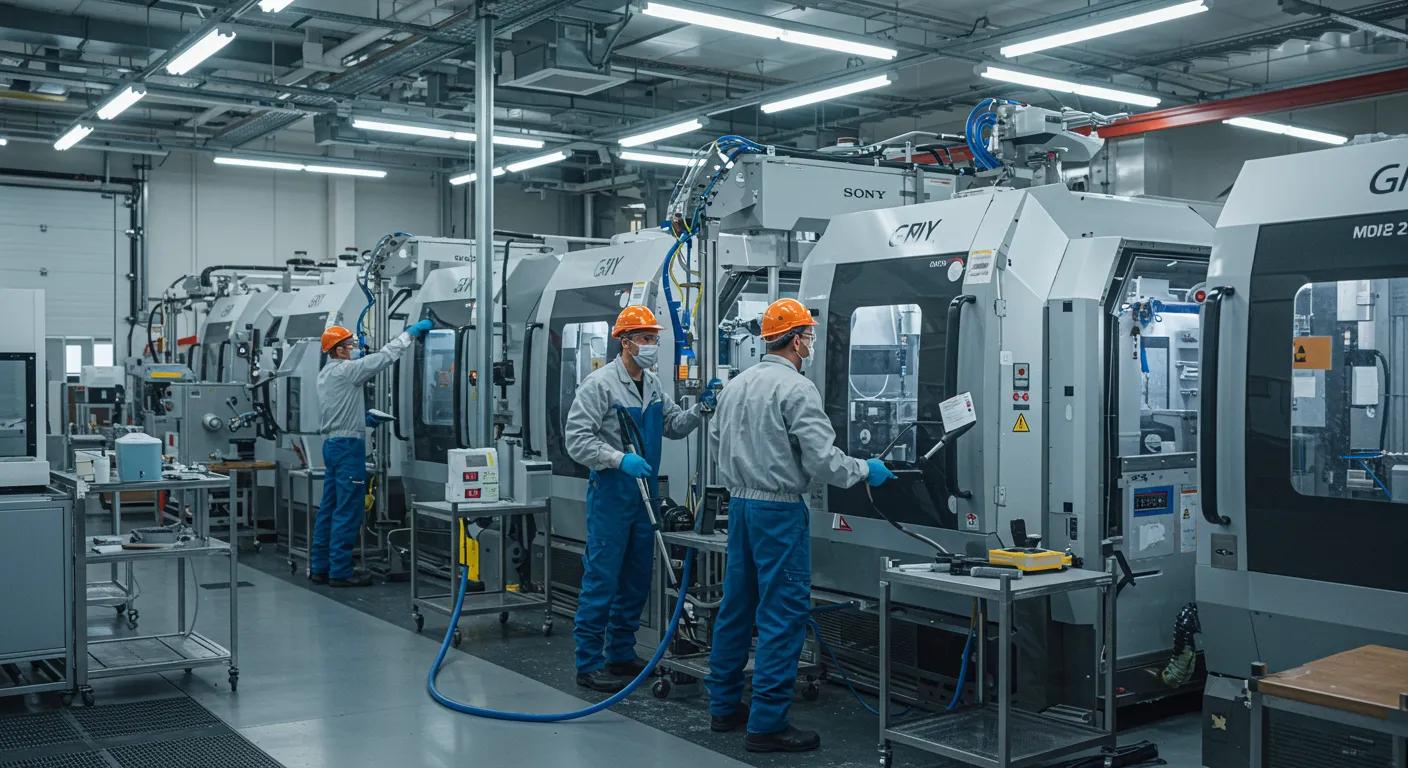
Selecting the right cleaning provider is crucial for maintaining high operational standards and ensuring ongoing compliance. The ideal provider should have extensive experience in industrial environments, proper certifications, robust safety records, and the ability to tailor their cleaning plans according to production needs.
Assessing a Provider’s Experience in Industrial Environments
Experience is crucial in industrial cleaning. Providers with a proven track record understand the complexities of handling heavy contaminants and can demonstrate success through case studies and client testimonials. Their deep understanding of environmental and safety regulations is essential for creating a tailored cleaning program.
Verifying Certifications and Insurance for Commercial Cleaning Services
A reputable cleaning provider should hold recognized certifications and comply with OSHA and EPA standards. Adequate liability insurance further protects both the provider and the facility. Facility managers should verify all certifications and insurance documents to ensure the provider meets industry requirements.
Requesting Detailed Cleaning Plans and Customization Options
A proficient provider will offer a detailed, customized cleaning plan covering the frequency, techniques, chemicals, and equipment used. Such plans should align with the facility’s production cycles and address its particular challenges, ensuring efficient and effective cleaning operations.
Evaluating Safety Records and Training Programs of Cleaning Companies
Strong safety records and comprehensive training programs are indicators of a reliable cleaning provider. Companies that invest in continuous employee training and maintain transparent safety records reduce the risk of accidents and ensure high-quality service delivery.
Understanding Contract Terms for Commercial Cleaning in Manufacturing Plants
Clear contract terms, including service level agreements (SLAs) and termination clauses, are essential for setting expectations. Contracts should detail the scope of services, pricing, and procedures for handling emergencies, protecting both parties and ensuring consistent performance.
Table: Comparison of Key Factors for Selecting a Cleaning Provider
This comparison helps facility managers evaluate vendors effectively and select a partner that meets high cleaning standards and regulatory requirements.
Final Thoughts
Industrial cleaning for manufacturing facilities is not just about maintaining appearance—it is a critical process that safeguards equipment, ensures compliance, and improves operational efficiency. By understanding core principles, distinguishing industrial from commercial cleaning, employing specialized techniques, adhering to strict safety protocols, and leveraging the benefits of outsourcing, facilities can achieve superior cleaning outcomes. A careful evaluation of a cleaning provider’s experience, certifications, detailed plans, and contract terms is essential for long-term success. Manufacturers are encouraged to invest in robust, professional cleaning solutions for a safer and more productive future.
Frequently Asked Questions
Q: How does industrial cleaning differ from standard janitorial services? A: Industrial cleaning uses specialized techniques and equipment to remove heavy contaminants and address production challenges. It focuses on deep cleaning machinery, managing hazardous waste, and meeting strict regulatory standards, going well beyond the basic tasks of traditional janitorial services.
Q: What specialized equipment is used in industrial cleaning? A: Industrial cleaning employs advanced tools such as high-pressure scrubbers, HEPA-filtered vacuums, automated robotic cleaners, and steam cleaning devices to effectively remove contaminants and protect sensitive equipment.
Q: Why is compliance with OSHA and EPA guidelines important in industrial cleaning? A: Adhering to OSHA and EPA guidelines helps mitigate workplace hazards, control chemical exposures, and ensure proper waste disposal, protecting workers, the environment, and the facility from legal and operational risks.
Q: What are the advantages of outsourcing cleaning services in manufacturing? A: Outsourcing provides improved worker safety, prolonged equipment lifespan, increased productivity through reduced downtime, consistent cleaning quality, and allows core staff to focus on production, thanks to the specialized expertise of professional cleaning providers.
Q: How often should manufacturing facilities schedule deep cleaning? A: The frequency depends on the type of contaminants and production schedules. Many facilities combine daily or weekly routine cleaning with more extensive deep-cleaning sessions during planned shutdowns to maintain productivity and prevent residue buildup.
Q: How can cleaning providers ensure consistent quality? A: Consistent quality is achieved through detailed cleaning plans, regular quality audits, proper documentation, and continuous staff training, supported by digital tracking systems that monitor cleaning performance and facilitate adjustments as needed.
Q: What factors should be considered when selecting a cleaning provider for a manufacturing site? A: Key factors include the provider’s industrial experience, certifications and insurance, the ability to customize cleaning plans, strong safety records and training programs, and clear contract terms to ensure high cleaning standards and regulatory compliance.

